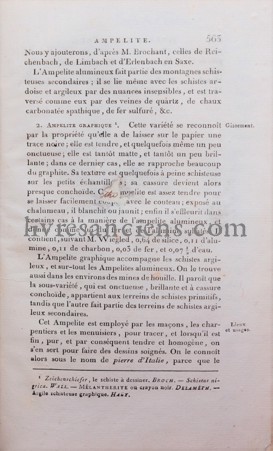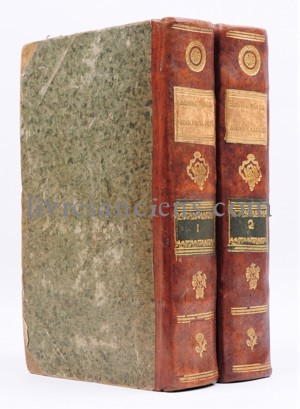
Paris, Deterville, 1807.
Deux volumes in-8 (195x124 mm), xii-564 pages et 4 pages de tables manuscrites / (4)-443-(1) pages et 16 planches hors texte dépliantes. Les planches 9 et 10 sont sur la même feuille.
Demi reliure à coins en basane de lépoque, dos lisse orné et doré portant les pièces de titre et de tomaison, tranches jaspées. Légers frottements. Petite tache à la page 225 et petite déchirure sans manque à la page 337 du volume 2. Manque de quelques lettres en milieu de texte de la page 563 du même volume.
Édition originale et premier ouvrage publié par lauteur.
Alexandre Brongniart (1770-1847) est un scientifique français principalement connu et reconnu pour ses travaux en Minéralogie. Il succède à René Just Haüy (lun des fondateurs de la cristallographie géométrique), à la chaire de Minéralogie au Muséum National dHistoire Naturelle de Paris.
Dès sa parution, cet ouvrage devient un classique dans le domaine et sert de référence pour les étudiants.
Provenance:
A M. Ant.e RUELLE, Payeur du Trésor royal. (ex-libris).
Références:
DSB [II, 494 : "a work commissioned as a textbook for his and Haüys courses at the Faculté des Sciences and the Muséum dHistoire Naturelle. He adopted a simple scheme of classification based mainly on physical properties, but he also made extensive use of Haüys crystallographic work. Like other mineralogists at this time, he could not easily distinguish some fine-grained rocks from true simple minerals; but he classed clay and basalt, for example, as fausses espèces, recognizing that they were mélangées although they were too fine-grained to be analyzed. He emphasized the importance of studying the modes of occurrence of minerals as well as their properties, but firmly avoided any discussion of their origins as being too speculative. The sole exception to this was a review of divergent opinions on the aqueous or igneous origin of basalt, but even in this he avoided expressing his own opinion" ], Curtis [I, 869].
ENGLISH DESCRIPTION
Two 8vo (195x124 mm), xii-564 pages and 4 pages of handwritten tables/ (4)-443-(1) pages and 16 folding plates. Plates 9 and 10 are printed on the same sheet of paper.
Contemporary half sheep, gilt flat spine, title and volume number in gilt on lettering-pieces, sprinkled edges. Minor rubbings. Small staining on page 225 and a minor tear without lack on page 337 of volume 2. Lack of few letters in the middle of the text on page 563 on the same volume.
First edition and first book by Brongniart.
Alexandre Brongniart (1770-1847) is a French scientist well-known and recognized for his research in mineralogy. He succeeded René Just Haüy (one of the founders of geometric crystallography), to the chair of mineralogy at the Muséum National dHistoire Naturelle of Paris.
As soon as it was published, this book became a classic in this field and was as a reference for students.
Provenance:
A M. Ant.e RUELLE, Payeur du Trésor royal. (bookplate).
Références:
DSB [II, 494 : "a work commissioned as a textbook for his and Haüys courses at the Faculté des Sciences and the Muséum dHistoire Naturelle. He adopted a simple scheme of classification based mainly on physical properties, but he also made extensive use of Haüys crystallographic work. Like other mineralogists at this time, he could not easily distinguish some fine-grained rocks from true simple minerals; but he classed clay and basalt, for example, as fausses espèces, recognizing that they were mélangées although they were too fine-grained to be analyzed. He emphasized the importance of studying the modes of occurrence of minerals as well as their properties, but firmly avoided any discussion of their origins as being too speculative. The sole exception to this was a review of divergent opinions on the aqueous or igneous origin of basalt, but even in this he avoided expressing his own opinion" ], Curtis [I, 869].
Photos / Pictures
Cliquez sur les photos pour les agrandir / Click on thumbnails to enlarge pictures











